Cooperation keeps intensive production profitable
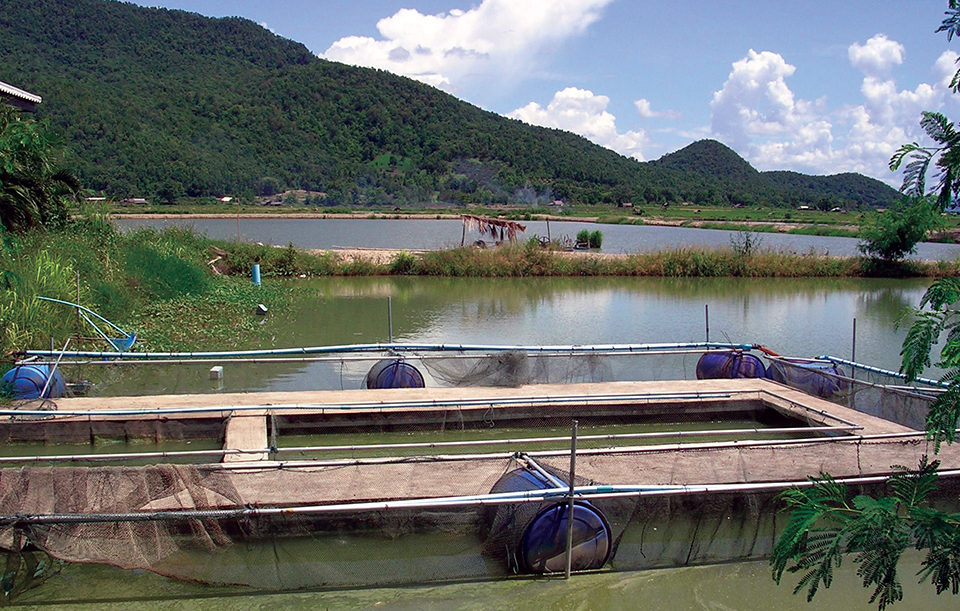
Thailand is an ideal location for production of giant freshwater prawns (Macrobrachium rosenbergii). The tropical climate, plentiful water resources, and multiple networks of manmade canals and natural waterways support high levels of year-round production, which had reached 29,000 metric tons (MT) on 8,320 hectares (ha) by 2005.
These prawns are cultured throughout Thailand, but farms are most concentrated in the central river valley of the Chao Phraya, which flows through Bangkok to the Gulf of Thailand. In Chachoengsao and the southern province of Nakhonsithammarat, farmers turned to prawn culture when local bans prohibited marine shrimp farming in inland areas.
Cooperative ventures
The farming of freshwater prawns is predominantly a cooperative and profitable venture that supports rural economies. Prawns are produced on small, privately owned farms by men and women, young and old. Higher education and specialized training are not necessary.
Farmers work together, hold local management meetings, share information with their neighbors, and in some areas work communally at harvest. Prawn farming is a very lucrative business that yields higher net profits than most other occupations, so farmers rarely subsidize their income with other activities.
Unlike marine shrimp production, the majority of prawns are sold for local consumption. Most farmers sell to traders at the farm gate, who sell at markets in Bangkok such as Chatuchak, or in Samut Sakhon’s Mahachai market. Prawns are also sold in district markets, restaurants, and hotels.
Production strategies
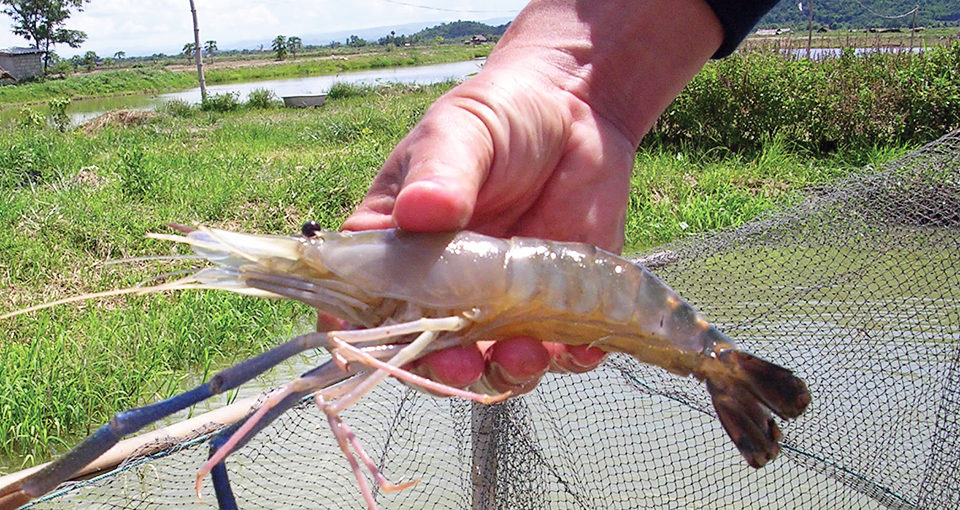
In a survey conducted by the first author during the summer of 2005, responses from 100 Thai prawn farmers provided useful information on their production practices and other elements of their operations.
Monoculture was the prawn culture system utilized by over 90 percent of the interviewed farmers. Polyculture with fish, integrated systems, or alternating with rice or other crops was uncommon.
Varied management strategies involved stocking nursery ponds with postlarvae or stocking directly into grow-out ponds, and harvesting with the batch or combined method. The most prevalent strategy, employed by almost 70 percent of the farmers, was to stock postlarval prawns in nursing ponds at high densities, utilizing water, land, and labor most efficiently. After 60 to 75 days, prawns were transferred to grow-out ponds, with the first harvest after five months.
Most farmers used a beach seine to harvest with the combined method, which culls only market-size prawns and leaves stunted individuals to continue growing. Additional harvests occured every 30 to 45 days. A full cycle can last eight to 13 months, after which all prawns are harvested and ponds are drained.
Less common management strategies included stocking postlarvae or juveniles purchased from neighboring farmers directly into grow-out ponds. Some farmers also chose to use batch harvesting, removing and selling all prawns after about five months. None of these strategies was significantly more profitable than another. Farmers who stocked juvenile prawns and utilized batch harvests were able to complete more cycles within a year, but could not grow prawns to the most profitable sizes.
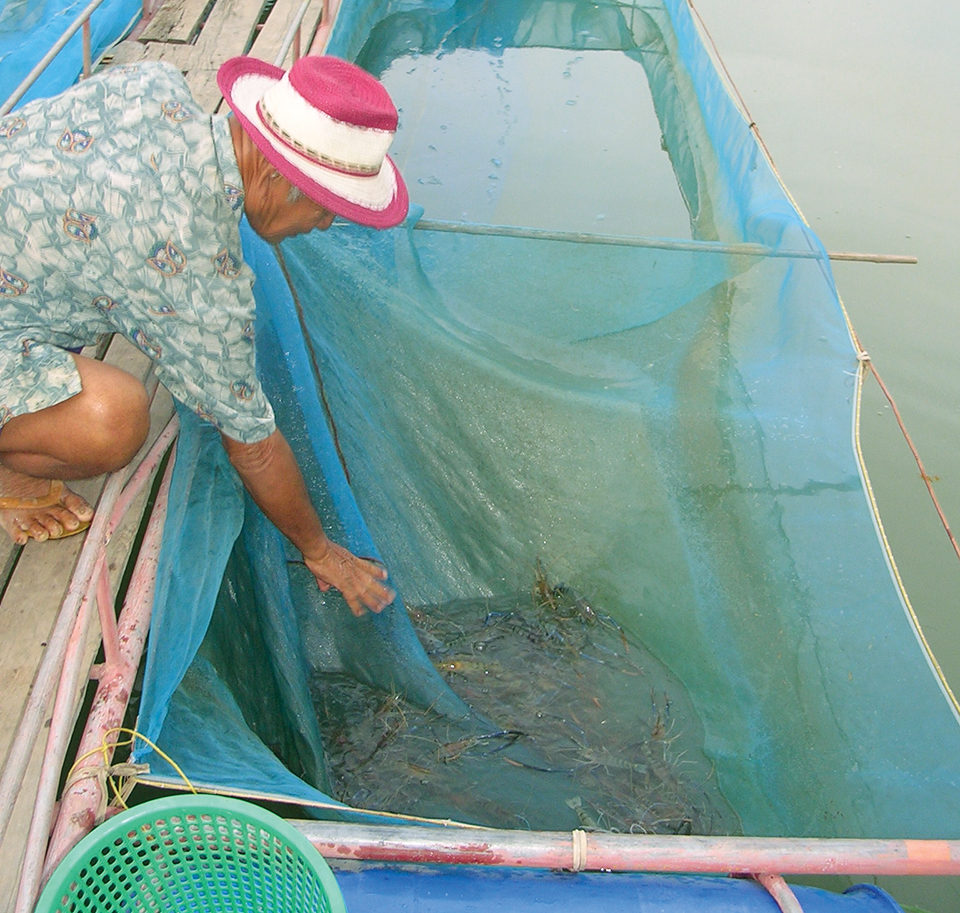
Pond management
Regardless of management strategy, prawn culture in Thailand is intensive, with high stocking densities and complete diets. Water management varies on each farm, and postcycle water treatment is uncommon. Most farms are less than 5 ha in size, and on average, ponds are 1.4 meters deep with clay substrates.
Farmers generally stocked grow-out ponds so the ultimate stocking density was less than 20 prawns per square meter. Seed was most often purchased from local hatcheries, but is also available from Kaset Somboon Farms or Charoen Pokphand, the largest agribusiness conglomerate in Thailand. In preparation for stocking, ponds were dried seven to 30 days, soil was tilled and plowed, and dikes were repaired. Ponds were treated most commonly with agricultural lime or dolomite, and salt was sometimes used in nursing ponds at 0.1 to 1.2 percent salinity.
The water used for prawn culture was most commonly obtained directly from natural or manmade canals. Area reservoirs and water storage ponds were uncommon. Prawns were stocked within 15 days after ponds were filled.
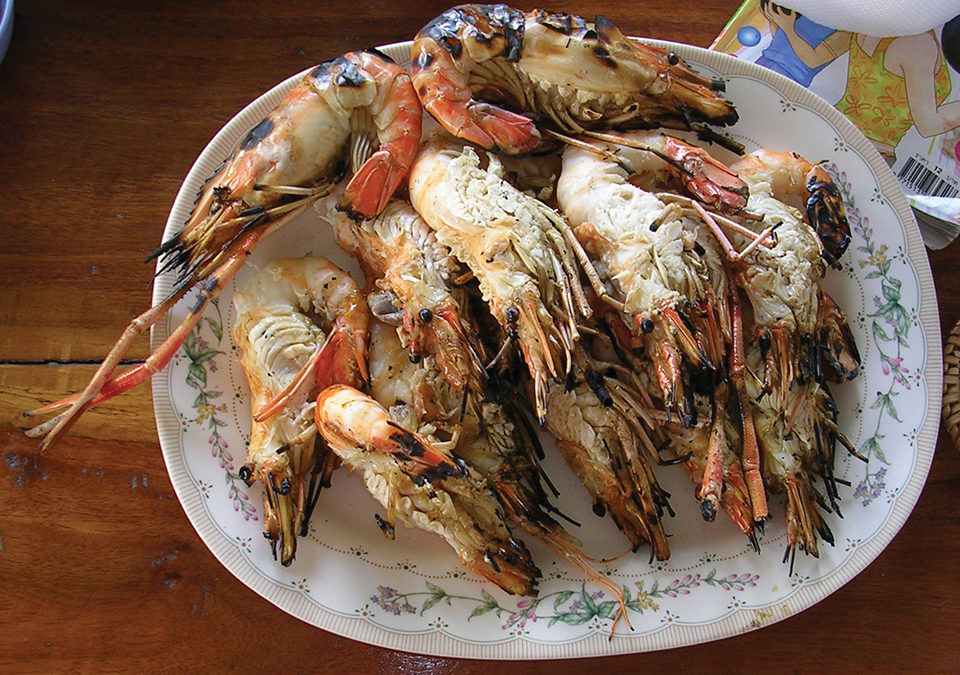
Feed
After prawns were stocked, they receive commercial feed that some farmers mixed with fresh trash fish or homemade feed. Shrimp feed was sometimes used during the nursing period. Feeding trays were utilized by many farmers, as well as broadcast feeding from dikes or boats.
Most farmers fed ad libitum rather than following feeding tables provided by the feed companies, and used their own judgment to adjust feeding rates by using feed trays or monitoring leftover feed on pond bottoms. The farmers’ average feed-conversion ratio was 2:1.
Water quality
Throughout the production cycle, farmers managed water regularly or only at times of poor water quality. Aeration was commonly provided throughout the cycle using paddlewheels, and water was exchanged or topped off every 12 days, on average, to maintain water quality. Diesel generators were the most common source of power for electrical aerators and pumps. Fertilization was not common and considered unnecessary by most.
Water quality in ponds was measured by approximately 40 percent of the interviewed farmers on a weekly to monthly basis. Most of these farmers focused on pH. Poor water quality was treated with lime, dolomite, zeolite, or water exchange to control pH. Farmers who did not measure water quality relied on visual inspection to assess pond health.
Settling ponds or water treatment after the culture cycle was not common in Thailand. After the culture period, approximately 90 percent of the interviewed farmers discharged water directly into canals that provide water for multiple users. Some discharged water into neighbors’ fish ponds or rice fields.
There was little regulation of effluents on a federal, provincial, or district level. The local governments in the provinces of Chiang Rai and Nakhonsithammarat required effluent permits, but these regulations were not strongly enforced. Farmers can receive certificates through the Good Aquaculture Practice program if they demonstrate sustainable farming methods that include effluent treatment and high standards of hygiene.
Financial aspects
Depending on management strategy, farmers can complete one cycle or more per year. Yearly production ranges 500 to 6,500 kg/ha/year, averaging 2,500 kg/ha/year. Farm gate and market prices for prawns are similar throughout Thailand, and prices increase with prawn size.
Females can sell for U.S. $1.25 to 3.75/kg, while males, which grow larger, are more profitable at $2.00 to 6.25/kg. A farmer can earn $24,000/year or more. This is well above the average household income calculated for the entire kingdom, which is approximately $4,000/year for a household of three or four people.
While prawn farming can reap high profit margins, it also involves large financial investment and can be risky. Necessary inputs such as feed and seed constitute approximately 80 percent of the costs, and feed is often bought on credit, making it more expensive. In some cases, inputs are not necessary or farmers choose not to use them.
For example, some farmers must rent an entire farm or a portion of the land. Farmland in Thailand rents for an average of U.S. $40/ha and can comprise almost 20 percent of total costs. Family labor is most common and free, but some farmers hired year-round permanent employees or casual labor just for harvesting. Also, not all farmers chose to aerate ponds or use chemicals for pond preparation or water management.
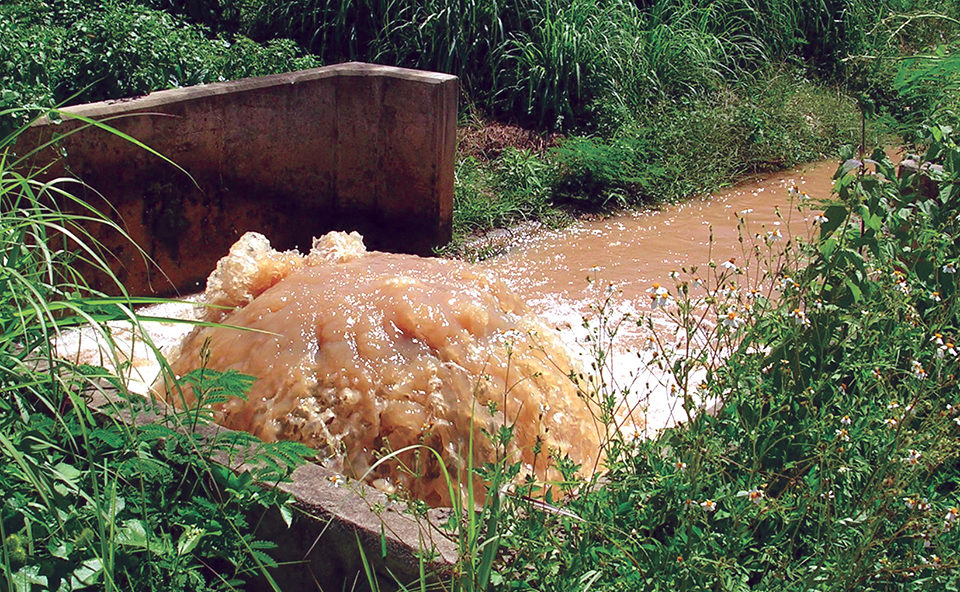
Major issues
Many farmers reported major issues with seed supply, disease, and external pollution. The seed supply is sometimes poor quality, diseased, or unavailable. Increases in outbreaks of Black Gill Disease in grow-out ponds lead to crop failure in many cases. Recently, an unknown disease spread quickly among farms and caused widespread crop failure. The Thai Department of Fisheries is currently trying to identify the pathogen.
The lack of effluent management has led to pollution problems from excessive levels of nutrients and pesticides in input water. Problems with acidity and a lack of water have occurred in the eastern provinces of Chonburi, Prachinburi, and Chachoengsao. Chachoengsao was a large inland shrimp production area until this practice was banned in 2000. A farmer in Chonburi reported that sometimes there was no water in the supply canal for up to five months.
Despite these problems, the farmers were interested in improving their operations and increasing culture knowledge. They said they would like to make multiple improvements, including changes to farm infrastructure as well as farm management.
Examples included increasing culture area, reducing stocking density, or alternating culture/polyculture with white shrimp. Approximately one quarter of farmers saw a need for alternative management techniques.
Outlook
The farming of freshwater prawns has potential to remain an integral part of the local Thai economy in the future. Many farmers prefer this to their previous occupations, and would like more information about prawn culture techniques, as well as government control of market prices and materials cost to reduce their financial risk.
In Chachoengsao, a farmer said freshwater prawn culture is a good business, especially if the prawn market price is higher than 100 baht/kg, or about U.S. $2.50/kg. Most farmers in Thailand agree and consider prawn farming a better alternative to rice farming.
However, future production may be hindered by the high nutrient discharges that result from current practices. Alternative culture systems and management strategies can be adopted to reduce the need for regulation and the risk of crop failure and fluctuations, and ensure a viable occupation for farmers in the future.
(Editor’s Note: This article was originally published in the January/February 2007 print edition of the Global Aquaculture Advocate.)
Now that you've finished reading the article ...
… we hope you’ll consider supporting our mission to document the evolution of the global aquaculture industry and share our vast network of contributors’ expansive knowledge every week.
By becoming a Global Seafood Alliance member, you’re ensuring that all of the pre-competitive work we do through member benefits, resources and events can continue. Individual membership costs just $50 a year. GSA individual and corporate members receive complimentary access to a series of GOAL virtual events beginning in April. Join now.
Not a GSA member? Join us.
Authors
-
Vicki Schwantes
School of Natural Resources and Environment
University of Michigan
Ann Arbor, Michigan 48109-1041 USA -
James Diana, Ph.D.
School of Natural Resources and Environment
University of Michigan
Ann Arbor, Michigan 48109-1041 USA -
Yang Yi, Ph.D
School of Environment, Resources, and Development
Asian Institute of Technology
Klong Luang, Pathumthani, Thailand
Tagged With
Related Posts

Health & Welfare
Freshwater prawn farming in Brazil
At present, Macrobrachium rosenbergii is the only shrimp species commercially farmed in Brazil. Most freshwater prawn farms are small, and prawn culture is often a secondary farming activity.

Intelligence
Adding flavor complexity to farmed barramundi
Organoleptic attributes such as flavor and aroma are among the most important factors that influence consumer acceptability and demand for fish products. Consumers have identified farmed fish as less complex and lacking “sealike” or “sea-fresh” flavors and aromas.

Intelligence
An inside look at Sino Agro Foods’ giant prawn MegaFarm
Sino Agro Foods has developed a proprietary recirculating aquaculture system that yields high production volumes and profitability. The facility should significantly contribute to seafood production in China and to help satisfy increasing demand for high value, safe and sustainably produced seafood.

Responsibility
Bangladesh study examines potential for prawn cage farming
While Bangladesh's prawn industry is based on pond culture, a feasibility study was conducted to establish prawn cage culture to benefit resource-poor fishers and landless people.


